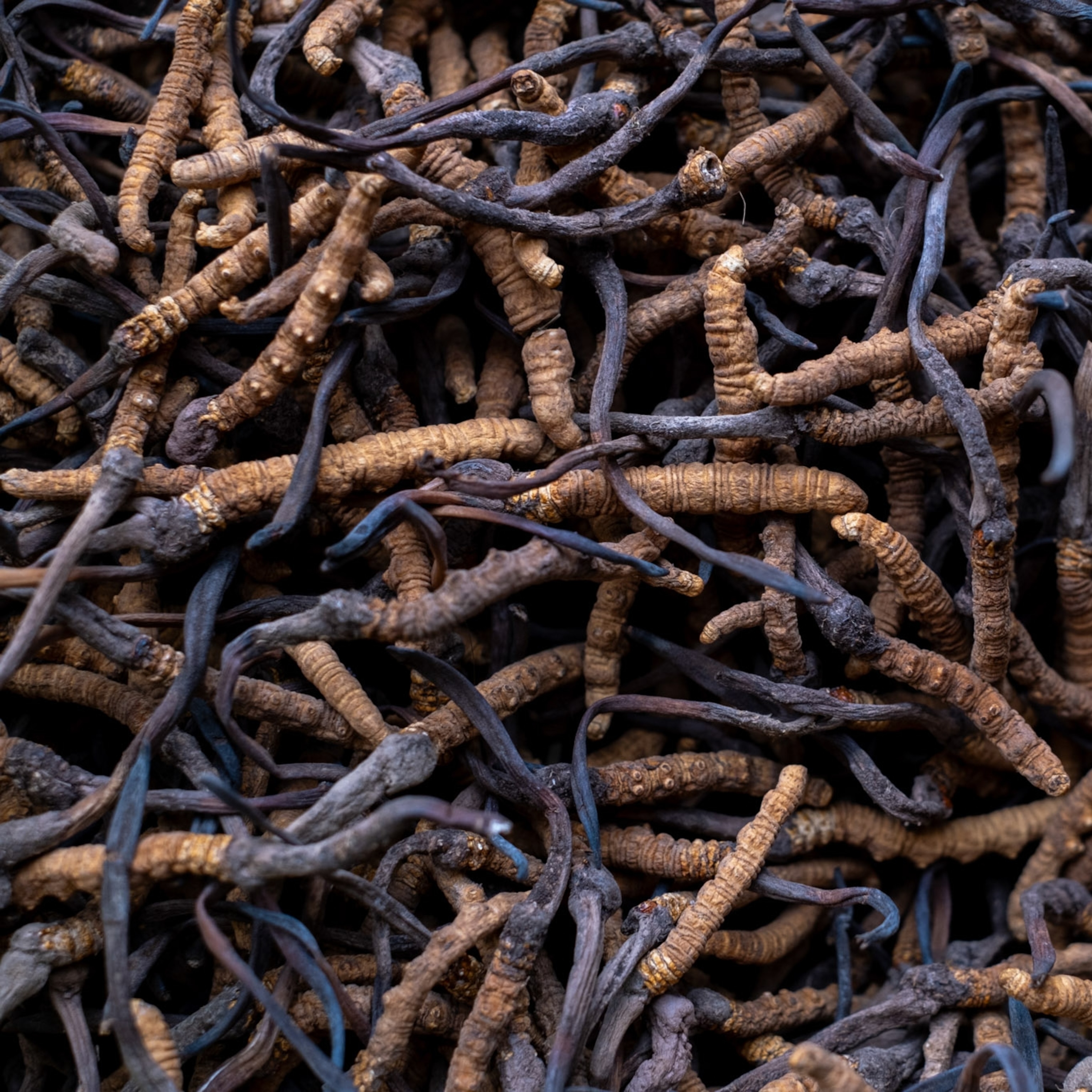
Love mushrooms? California is having an epic 'supershroom' season
This mushroom season is one for the record books. Here’s why—and how to start shroom-hunting.
Somewhere in Southern California — Stu Pickell, mushroom hunter, is elbow-deep in dirt.
Lying flat on the ground in a narrow canyon under a towering bigcone Douglas fir, he paws up handfuls of gently fragrant humus. Occasionally he sniffs it, searching for the scent of his quarry: a unique type of black truffle that hasn’t ever been observed before in drought-parched Southern California. This tiny pocket of trees in the Santa Ana Mountains could be its ideal habitat, he thinks—and now could be the best time ever to actually find it.
Normally at this time of year, Pickell might be hunting for chanterelles in Mendocino or searching for slime molds in Alaska. But today, the fungi aficionado and photographer is searching just a few minutes from home, near Los Angeles’s suburbs—barely out of sight of the city, but in a whole different world.
That’s because over the past few months, a remarkable series of deluges, unexpected for drought-stricken California, have sparked an epic, once-in-a-blue-moon mushroom season, giving mushroom hunters across the state a chance to pursue their passion in their own backyards.
“It’s a super-shroom!” says Justen Whittall, a botanist at Santa Clara University—the mushroom equivalent of a wildflower “superbloom.” Years this good are rare in Southern California; some hunters say the last was in 1997, more than 20 years ago.

The abundance is astounding, he says. Citizen scientists are plucking dozens of never-before-described mushroom species from the soil. Mushroom hunters have been selling truckloads of dinner plate-size chanterelles, often worth thousands of dollars, to fancy restaurants. About 150 people attended a recent morning walk at the Los Angeles Mycological Society’s annual fair to see mushrooms popping up in city parks and sidewalk cracks.
Even for those new to the fungi world, this is a perfect time to get in on the action, says Bat Vardeh, a mushroom enthusiast and founder of the naturalist group Women Forage Socal.
In dry years, “mushrooms can be everywhere around you, and invisible at the same time,” she says—hiding in soil and waiting for rain. But this year, they’re right out in the open, ready to be seen; admired; and in many cases, eaten.
The magic of mushrooms
Fungi may represent one of the greatest outstanding scientific mysteries of the modern world.
There are an estimated three or more million species—but only about 150,000 have been described scientifically. We’ve also only scratched at the surface of their potential as food, medicine, environmental cleanup agents, and more.


“In your own backyard you can find something that has never been seen before,” says Else Vellinga, a mycologist at the University of California, Berkeley.
Many species lurk undetected as mycelium, a root-like network of often underground fungi. Genetic analyses of DNA fragments found in single handfuls of soil often uncover dozens of fungal species.
That richness was on display in the Santa Anas. In just one small patch of forest floor, Pickell and his friend Christian Schwarz (who literally wrote the book on California mushrooms) found species after species: tiny chartreuse cup fungi, delicate red pinwheels, lavender blewits, metallic-capped pluteus mushrooms, and many more (but no black truffles, Pickell’s quarry of the day).
Such a mushroom explosion is a boon for the fungi-curious, from experts like Pickell and Schwarz to anyone with a smartphone with a camera and the iNaturalist app. But it also underscores a real problem: Because we don’t know what species exist and where, it’s challenging to see how climate and ecological change affects fungi.

“We know we’re losing species,” says Gordon Walker, scientist and host of the popular Fascinated by Fungi Instagram, TikTok, and podcast. “We just don’t know how many or how fast.”
Why this is such a mushroom-rich year
But fungi are also consummate survivors. Give a mushroom an inch, conditions-wise, and it’ll take a mile.
Bob Cummings, a mycologist at Santa Barbara City College, has been mushroom hunting for 60 years. His first mind-blowing season was 1982 to 1983, when one of the most powerfully rainy seasons on record hit California. Chanterelles were practically popping out of the woodwork. Another epic season came along in 1997. But he’d almost given up hope for another exceptional year, since Southern California, along with much of the U.S. Southwest, has been stuck in a 20-year drought.
Those rainy years tend to come during an El Niño event, a climatic phenomenon that usually brings wet weather to the Pacific coast, from California to Chile. But recent years have seen the opposite, a La Niña pattern characterized by dry winters. “The last few years have been terrible,” says Jess Starwood, a forager from the Los Angeles area. “I didn’t see a single chanterelle.”
Scientists forecast the dry pattern would prevail once again this winter. But instead, a series of remarkable atmospheric rivers streamed across the skies, dumping as much as 600 percent of the normal rainfall in some parts of California, overtopping dams and destroying homes.
And mushrooms thrive on moisture. Dampness plus the right environmental conditions, like chilly night temperatures, triggers mycelium to fruit, sending up the forms we more readily recognize as mushrooms.

In February, several weeks after the most recent rain, Starwood crunches through thick oak leaf duff in the low hills of mountains near L.A. We’re barely out of sight of homes when she darts toward a barely visible hump in the leaves—a “shrump,” in mushroom parlance. She gently dusts away the leaves and just like that, the prize appears. She’s found a dense, fragrant, valuable chanterelle (later, she’ll sell it to n/naka, an upscale restaurant in L.A.).
“Oooh, yay, yay, yay,” she says gleefully as she carves it from the soil with a flip-out blade. “It’s just so thrilling to find them, every time.”
How to develop your 'mushroom eyes'
Even if you’re not in the middle of the supershroom, it’s always a good time to learn the thrills of mushroom hunting—and be part of remarkable citizen science efforts to understand and protect them, like the nationwide Fungal Diversity Survey, or FunDiS.
The first step is to go out into the world and develop your “mushroom eyes,” says Cummings. During the damp season, find a natural spot, preferably one with mushroom-hosting trees such as oaks or pines, damp swales, or mulch and decomposing wood. Then, just start looking closely. You might be surprised how easy it is to tune your vision to fungi. “They appear like from nowhere,” he says.
Starwood compares learning to read a landscape for mushrooms with learning a new language.
“First you’re looking out at a wall of green; how do you even start breaking it apart?” she says. “Then you learn a word, or two words—seasons, timing, shade conditions, where water goes, tree species—and soon it comes together, and you can speak fluent nature.” That’s when you stumble across remarkable finds.
Mycological associations often host walks and events to help people learn to identify finds and develop your eyes. Local naturalist groups are also invaluable, says Pickell—as is a good guidebook.
Most important? Never eat anything that you haven’t identified with full certainty.
Mushroom hunting will change the way you look at the world, says Vardeh. Suddenly, you’ll see all the places their host trees—like majestic old oaks—are threatened by wildfire or development, or where mycelium-rich soil is disrupted by plowing.
“It feels like going from walking into a room of strangers to a room full of friends,” she says.
You May Also Like
Go Further
Animals
- We finally know how cockroaches conquered the worldWe finally know how cockroaches conquered the world
- Move over, honeybees—America's 4,000 native bees need a day in the sunMove over, honeybees—America's 4,000 native bees need a day in the sun
- Surveillance Safari: Crowdsourcing an anti-poaching movement in South Africa
- Paid Content
Surveillance Safari: Crowdsourcing an anti-poaching movement in South Africa - Fireflies are nature’s light show at this West Virginia state parkFireflies are nature’s light show at this West Virginia state park
- These are the weird reasons octopuses change shape and colorThese are the weird reasons octopuses change shape and color
- Why young scientists want you to care about 'scary' speciesWhy young scientists want you to care about 'scary' species
Environment
- What rising temperatures in the Gulf of Maine mean for wildlifeWhat rising temperatures in the Gulf of Maine mean for wildlife
- He’s called ‘omacha,’ a dolphin that transforms into a man. Why?He’s called ‘omacha,’ a dolphin that transforms into a man. Why?
- The northernmost flower living at the top of the worldThe northernmost flower living at the top of the world
- This beautiful floating flower is wreaking havoc on NigeriaThis beautiful floating flower is wreaking havoc on Nigeria
History & Culture
- Scientists find evidence of ancient waterway beside Egypt’s pyramidsScientists find evidence of ancient waterway beside Egypt’s pyramids
- This thriving society vanished into thin air. What happened?This thriving society vanished into thin air. What happened?
Science
- Why pickleball is so good for your body and your mindWhy pickleball is so good for your body and your mind
- Extreme heat can be deadly – here’s how to know if you’re at riskExtreme heat can be deadly – here’s how to know if you’re at risk
- Why dopamine drives you to do hard things—even without a rewardWhy dopamine drives you to do hard things—even without a reward
- What will astronauts use to drive across the Moon?What will astronauts use to drive across the Moon?
- Oral contraceptives may help lower the risk of sports injuriesOral contraceptives may help lower the risk of sports injuries
- How stressed are you? Answer these 10 questions to find out.
- Science
How stressed are you? Answer these 10 questions to find out.
Travel
- The ‘Yosemite of South America’ is an adventure playgroundThe ‘Yosemite of South America’ is an adventure playground
- These farmers make it possible for hikers to access Alpine trailsThese farmers make it possible for hikers to access Alpine trails
- A guide to Philadelphia, the US city stepping out of NYC's shadowA guide to Philadelphia, the US city stepping out of NYC's shadow
- How to make perfect pierogi, Poland's famous dumplingsHow to make perfect pierogi, Poland's famous dumplings
- The best long-distance Alpine hike you've never heard ofThe best long-distance Alpine hike you've never heard of





